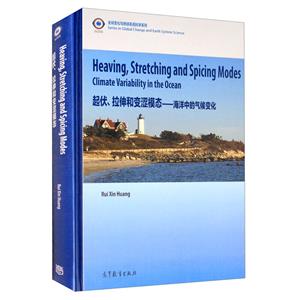-
>
宇宙、量子和人類心靈
-
>
氣候文明史
-
>
南極100天
-
>
考研數(shù)學(xué)專題練1200題
-
>
希格斯:“上帝粒子”的發(fā)明與發(fā)現(xiàn)
-
>
神農(nóng)架疊層石:10多億年前遠(yuǎn)古海洋微生物建造的大堡礁
-
>
聲音簡(jiǎn)史
起伏、拉伸和變澀模態(tài)——海洋中的氣候變化 版權(quán)信息
- ISBN:9787040542554
- 條形碼:9787040542554 ; 978-7-04-054255-4
- 裝幀:一般膠版紙
- 冊(cè)數(shù):暫無(wú)
- 重量:暫無(wú)
- 所屬分類:>>
起伏、拉伸和變澀模態(tài)——海洋中的氣候變化 內(nèi)容簡(jiǎn)介
This book is focused on fundamental aspects of climate variability in the ocean, in particular changes of the wind-driven circulation. The vertical movement of isopycnal (isothermal) layers, including their stretching and compression, is called heaving and stretching. A major part of climate vanability in the ocean is heaving in nature. Heave is primarily associated with the adiabatic motions of isopycnal layers due to change of wind stress. It is rather difficult to separate the contributions from adiabatic and diabatic processes. Isopycnal analysis has been widely used in climate study; however, it is much more accurate to study the isopycnal layers.-Here climate signals are examined in terms of changes of layer depth, layer thickness, layer temperature/salinity, spicity and others.In addition to the traditional Theta-S diagram, the sigma-pi (potential density - potential ispicity) diagram-can also be used in anatyzing water mass property distribution and climate variability. In fact, a radius of signal can be defined rigorously for signals in the sigma-pi diagram; the combination of isopycnal analysis and evaluation of radius of signal provides a powerful tool in analyzing climate variability in the world oceans.
起伏、拉伸和變澀模態(tài)——海洋中的氣候變化 目錄
1.1 Roles of Wind in Climate Variability
1.2 Main Thermocline in the World Oceans
1.3 Reduced Gravity Model, Advantage and Limitation
1.3.1 Model Formulation
1.3.2 The Reduced Gravity in the World Oceans
1.4 Layer Outcropping: The Physics and the Numerical Method
References
2 Climate Variability Diagnosed from the Spherical Coordinates
2.1 Climate Variability Diagnosed in the z-Coordinate
2.2 External/lnternal Modes in Meridional/Zonal Directions
2.2.1 Heat Content Anomaly
2.2.2 Salinity Anomaly
2.2.3 Density Anomaly
2.3 Adiabatic Signals in the Upper Ocean
2.3.1 Adiabatic Adjustment in the Upper Ocean
2.3.2 Adiabatic Wave Adjustment in the Meridional Direction
2.4 The Regulation of MOC (MHF) by Wind Stress and Buoyancy Anomalies
2.4.1 Introduction
2.4.2 Surface Density Anomaly
2.4.3 Correlation Between Surface Forces and MOC
2.4.4 Conclusion
2.5 Adiabatic Heaving Signals in the Deep Ocean
2.6 Final Remarks
References
3 Heaving, Stretching, Spicing and Isopycnal Analysis
3.1 Heaving, Stretching and Spicing Modes
3.1.1 Adiabatic and Isentropic Processes
3.1.2 Heaving, Stretching and Spicing Modes
3.1.3 External Heaving Modes Versus Internal Heaving Modes
3.1.4 Wave Processes Related to Adiabatic Internal Heaving Modes
3.1.5 Local Versus Global Heaving Modes
3.2 Potential Spicity
3.2.1 Introduction
3.2.2 Define Potential Spicity by Line Integration
3.2.3 Define Potential Spicity in the Least Square Sense
3.2.4 Solve the Linearized Least Square Problem
3.2.5 Potential Spicity Functions Based on UNESCO EOS-80
3.2.6 Potential Spicity Functions Based on UNESCO TEOS_10
3.3 σ-π Diagram and Its Application
3.3.1 The Meaning of Spicity
3.3.2 Density Ratio Inferred from the Density-Spicity
Diagram
3.3.3 The σ-π Plane as a Metric Space
3.4 Isopycnal Analysis
3.4.1 The Lagrangian Coordinate
3.4.2 Isopycnal Analysis in the Eulerian Coordinate
3.4.3 Isothermal Analysis
References
……
4 Heaving Modes in the World Oceans
5 Heaving Signals in the Isopycnal Coordinate
6 Heaving Signals in the Isothermal Coordinate
7 Climate Signals in the Isohaline Coordinate
Index
- >
推拿
- >
【精裝繪本】畫給孩子的中國(guó)神話
- >
莉莉和章魚
- >
二體千字文
- >
山海經(jīng)
- >
回憶愛瑪儂
- >
人文閱讀與收藏·良友文學(xué)叢書:一天的工作
- >
企鵝口袋書系列·偉大的思想20:論自然選擇(英漢雙語(yǔ))















